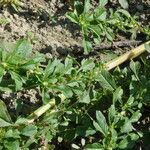Plants annual, pubescent in distal parts or becoming glabrescent at maturity. Stems erect to ascending or decumbent, branched at or distal to base, 0.1-0.9 m. Leaves: petiole variable in length; blade lanceolate to nearly linear or rhombic-ovate to elliptic-ovate, (1.5-)2-4(-5) × 1-3 cm, base cuneate to broadly cuneate, margins entire, plane, rarely indistinctly undulate, apex subacute to obtuse or emarginate, mucronulate. Inflorescences axillary glomerules, green. Bracts lanceolate, subspinescent, 1.5-2 mm, shorter or slightly longer than tepals. Pistillate flowers: tepals 3, erect, elliptic to lanceolate-elliptic, equal or subequal, 1.5-2 mm, apex short-acuminate; style branches slightly spreading; stigmas (2-)3. Staminate flowers intermixed with pistillate; tepals 3, equal or subequal; stamens 3. Utricles subglobose to broadly elliptic, 2-2.5 mm, slightly rugose, dehiscence regularly circumscissile, rarely irregularly dehiscent. Seeds black, lenticular, 1-1.3(-1.6) mm diam., smooth or indistinctly punctate.
Erect or spreading, much-branched, glabrous or almost glabrous, annual herb to c. 80 cm high. Stems angled, glabrous or puberulent, white, slightly pink towards base. Petiole slender, < to slightly > lamina. Lamina 1-2.5 × 0.3-1.5 cm, obovate-lanceolate, obovate, or suborbicular, glabrous, sometimes with greyish central band above when fresh; base cuneate or attenuate; apex obtuse or emarginate, mucronate; lvs on non-flowering plants broadest. Infl. an axillary cluster of greenish fls, present in nearly all lf axils. Bracteoles 3-4.5-(5) mm long, lanceolate-subulate, slightly folded, with acute but not pungent keel. Tepals 3, unequal, 1.5-3 mm long, oblong or lanceolate; keel green; apex acute, acuminate to subulate. Fr. subglobose, = to > tepals, slightly rugose, circumscissile at c. middle. Seed 1-1.5 mm diam., globose or subglobose, dark brown.
Perianth segments 3, all 1.5–2 mm. long; those of the male flowers lanceolate-oblong, cuspidate, pale membranous with a narrow green midrib excurrent in a short, pale arista; those of the female flowers lanceolate-oblong to linear-oblong, gradually to abruptly narrowed to the mucro, the midrib often bordered by a green vitta above and apparently thickened, the margins pale whitish to greenish.
Leaves glabrous or sometimes sparingly furnished on the lower surface of the principal veins with very short, gland-like hairs, long-petiolate (petiole from 3–45 mm. long, sometimes longer than the lamina), lamina broadly ovate or rhomboid-ovate to narrowly linear-lanceolate, 4–55 × 2–30 mm., acute to obtuse or obscurely retuse at the mucronulate apex, cuneate to long-attenuate at the base.
An annual plant growing up to 50 cm high. The plant is sprawling over the ground. It has a taproot. The branches do not have hairs. The flowering shoots are leafy. The flowers are in small clusters. They are greenish.
Bracts and bracteoles narrowly lanceolate-oblong, pale-membranous, acuminate and with a pale or reddish arista formed by the excurrent green midrib, bracteoles subequalling or usually shorter than the perianth.
Capsule subglobose to shortly ovoid, 2–2.25 mm. usually strongly wrinkled throughout with a very short, smooth beak, exceeding the perianth, circumcissile or sometimes not, even on the same plant.
Stem slender to stout, angular, glabrous or thinly to moderately furnished with short to long, often crisped multicellular hairs which increase upwards, especially in the inflorescence.
Annual herb, branched from the base and usually also above, erect, decumbent or prostrate, mostly up to c. 45 cm. (rarely to 70 cm. high).
Flowers all in axillary cymose clusters, male and female intermixed, male commonest in the upper cymes.
Seeds shining, compressed, black, 1–1.25 mm. across, faintly reticulate especially towards the margin.
Stigmas 3, slender, usually pale, flexuose, c.0.5 mm. long.
A variable weed, up to 2 ft. high.

